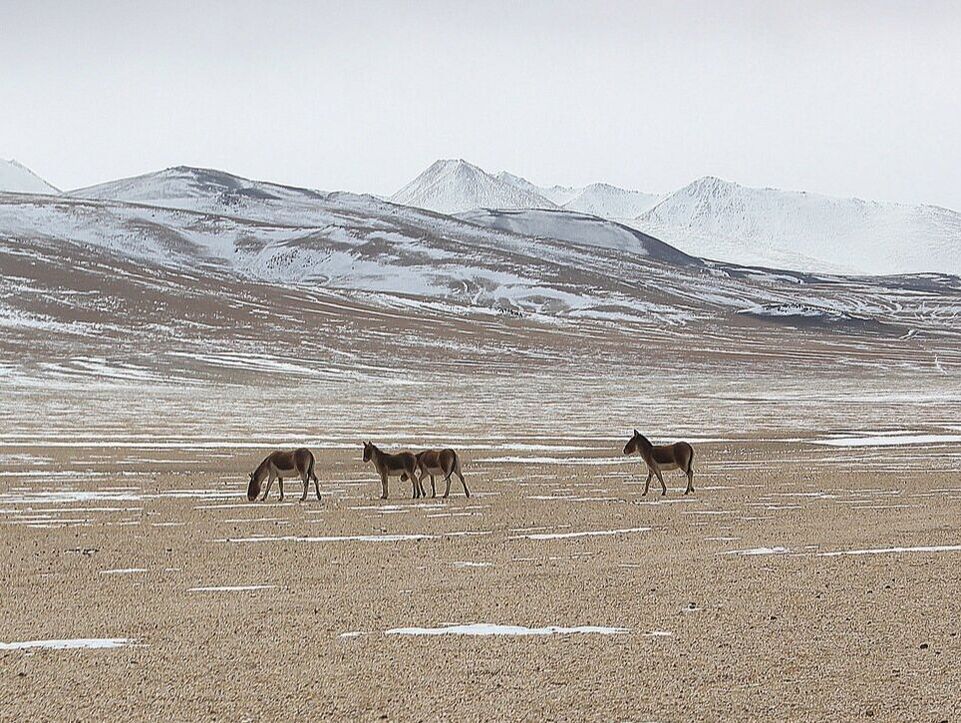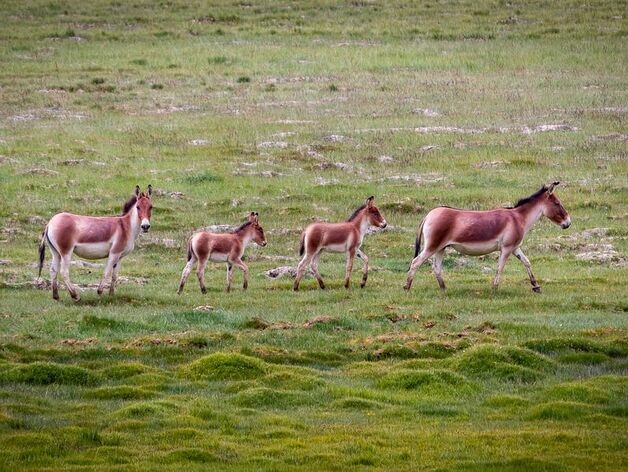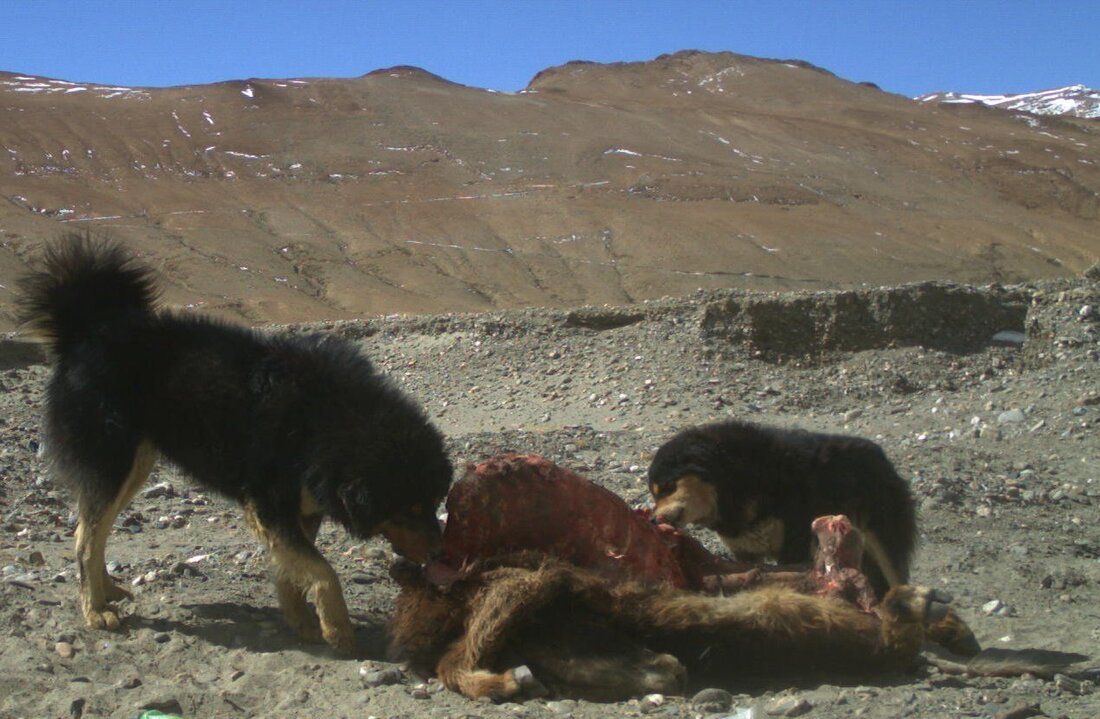The Foe in Our Best Friend: Interactions between Free-Ranging Dogs and Wild Animals in Changthang Plateau
By
Subhashini Krishnan
|
In the village of Hanle (which was my base camp for four winter months) every time I inquired somebody about sighting a Tibetan wolf (Canis lupus chanco), the most common response was “Oh! You will be able to spot them around the villages. Don’t worry. Your only trouble will be to differentiate between ‘shanku’ (wolf) and ‘Kee’ (dog) - they pretty much look the same and we have a lot of dogs”. Hearing that sentence over and over again made me realise that even if I see a wolf, I am going to be stuck with eternal confusion because most of the wolf sightings happen in low-light conditions and it is difficult to differentiate from silhouettes. The only wolf-sightings I was sure of were the ones away from villages. Dogs always kept close to human settlements of any kind (villages, nomad camps, defence camps) and hardly ventured farther from the villages. |
Changthang is Special!
The eastern Ladakh landscape is a part of the Tibetan high plateau, called the Changthang plateau, and is considered an important highland grazing ecosystem. This area is usually characterized by low precipitation (200 mm - 400 mm), low temperature (- 35 to 25 ℃), and high elevation (4100 m- 5200 m). Harsh climatic conditions and low plant productivity, have resulted in unique fauna and flora that are highly adapted to this landscape. The vegetation scene is dominated by Poaceae, Asteraceae, and Cyperaceae species. During the summer months, the intense agriculture presents fields of barley and peas amidst the natural vegetation. The fauna of this region has much in common with Central Asia and more so, with the Tibetan plateau which is an extension of the Indian Changthang. However, birds from the Indian sub-continent do migrate here during the summer months. Primary mammal species in the field site include Tibetan Wild Ass, Blue Sheep, Tibetan Wolf, Red Fox, Palla’s Cat, Eurasian Lynx, Snow Leopard, Wooly Hare, Marmot, Pika, and Vole. The primary resident winter birds include Horned Lark, Tibetan Snowfinch, Hill Pigeon, Northern raven, Upland Buzzard, Golden Eagle, and Bearded Vulture. Summer migrant birds and hibernating mammals like Marmot appear in the scene during April and May.
The cold desert landscape of Ladakh exhibits one of the highest overlaps of resource utilisation by humans and wildlife. The Indian Changthang region of Ladakh has a tribal population called the ‘Changpas’ who are traditionally nomadic pastoralists. Known for being one of the important pashmina/cashmere wool production centres, the number of goats and sheep seems to have had a steady decline in the past twenty years. As the people have begun to give up nomadic lifestyle and take up rigorous agricultural practices during the short and conducive growing months from May to September, there are increasing village settlements by the otherwise nomadic pastoralists.
Hardly a Friendly Wag
With my study, I aimed to paint the picture of dogs amidst all the specially evolved life on this landscape.
Was there something unique about these domestic dogs in the trans-Himalayan landscape too?
Domestic dogs are the most abundant terrestrial carnivores on this planet. There are increasing accounts of free-ranging domestic dogs threatening wildlife and human life as well. The situation is the same in this landscape too. The most important warning I received was to keep my distance, not from the wild predators, but from dogs. Apart from the dogs commonly used for shepherding, most free-ranging dogs form groups that almost always appear hostile. Mid-December, when I had first arrived at the city of Leh and spoke to people about my purpose of the study, most of them narrated a story of someone they knew being attacked in the alley of Leh marketplace by groups of dogs. As I moved to the village of Hanle, I heard about several dog attacks on humans as well as the livestock and occasionally about wildlife.
In a landscape of tiring scarcity, food resources play an important role in determining the survival of any species. My study helped me understand how vital these resource points were for the free-ranging dogs - the resource points here being settlements by villagers as well as defence camps. With the continued supply of food wastes, dead livestock, and shelter from the harsh winter, the dogs are able to sustain and reproduce. During summer the waste generated by tourism, adds to the increasing resources that these dogs can utilise.
In a landscape of tiring scarcity, food resources play an important role in determining the survival of any species. My study helped me understand how vital these resource points were for the free-ranging dogs - the resource points here being settlements by villagers as well as defence camps. With the continued supply of food wastes, dead livestock, and shelter from the harsh winter, the dogs are able to sustain and reproduce. During summer the waste generated by tourism, adds to the increasing resources that these dogs can utilise.
Trouble is Brewing
The emergent practice of settling by the previously nomadic Changpa tribes, with an increasing number of defence camps, acts as one of the major drivers of the increasing dog densities. This calls drawing up important conservation measures for the native wildlife of Changthang Wildlife Sanctuary as they are now faced with new predators/competitors. In the winters, it is mostly the carnivores of the landscape that have negative interactions with the free-ranging dogs. Foxes and wolves that tend to visit the livestock carcasses or the garbage dumps, end up fighting for a morsel from these dogs. One of the interesting encounters I witnessed was when a pair of wolves were chased away from a dead cow carcass. In another instance, a kiang (Tibetan wild Ass ) that was killed by a pack of wolves was stolen from them by a group of dogs. Foxes seem to have managed to get away with occasional food bites even in presence of dogs. However, my most often sighted interaction involved foxes being chased dogs, and given the foxes nimble movements, they always managed to escape. In summer, the situation for wildlife is even grave under the landscape dominated by free-ranging dogs acting as top predators. Marmots, voles, hares, and the migrating water birds are swiftly and ably targeted by the dogs.
Free-ranging dogs also end up over-powering shepherd dogs by the sheer number and group strength. When they pick off stray or young livestock, the villagers are left clueless about the one who committed the deed often due to the similar appearance and style of hunting to the wolves in the region. Many concerns also emerge about dogs potentially carrying pathogens and transmitting diseases as they act as this bridge between domestic and wild systems. Will this also pose a threat to wolf conservation? There is surely potential for that.
Free-ranging dogs also end up over-powering shepherd dogs by the sheer number and group strength. When they pick off stray or young livestock, the villagers are left clueless about the one who committed the deed often due to the similar appearance and style of hunting to the wolves in the region. Many concerns also emerge about dogs potentially carrying pathogens and transmitting diseases as they act as this bridge between domestic and wild systems. Will this also pose a threat to wolf conservation? There is surely potential for that.
In a landscape of tiring resources scarcity and limited carrying capacity, high numbers of free-ranging dogs add additional stress on the survival of all other species. As ascertained above, free-ranging dogs indeed pose problems to people, livestock, and wildlife. Thus conservation in this landscape has to begin by eliminating the most evident and increasing threat.
Acknowledgments: My survival in this landscape would not have been possible without the people of Hanle who welcomed me into their homes, fed me, cared for me, and helped me with collecting information for this study - Paljor, Dolma, Kesang, Tsomo, Stanzin, and Yurgyal. This study was conducted as part of my Master’s dissertation course at Wildlife Institute of India - Dr. Lallianpuii, Dr. YV Jhala, and Dr. Sutirtha - who supported me with guidance this study. Finally, a note of gratitude to the Department of Wildlife Protection (Leh-Ladakh) for their logistical support.
|
04/09/2021
|
Explore I Share
|
Subhashini Krishnan
|
She is an early-career conservation biologist. Her interests lie at the intersections of grasslands, canids, and pastoralists. Always ready to answer the call of the wild, her perfect day involves a good cup of coffee followed by tracking paw prints and howls in the wilderness.
|









